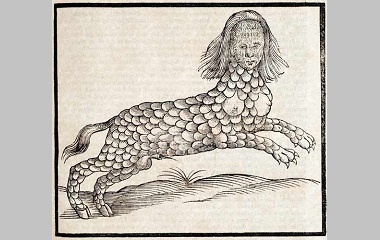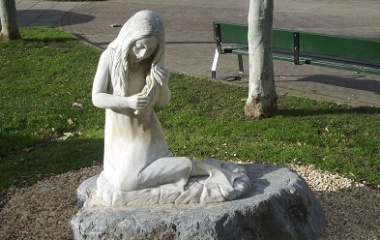Who is Lamia?
Lamia is a devastatingly beautiful monster, part woman and part serpent. Before she was cursed with her terrible new form, she was a powerful but relatively innocent woman. Now, she is a bloodthirsty villain who slithers through the darkness of the night, searching for children to devour, or walks in beauty through the daylight, searching for men to make her dessert.
Characteristics
Physical Description
According to ancient Greek tradition, Lamia has the head and breasts of a woman, but the rest of her body is serpentine. By some accounts, her chimeric form is hideous, but other writers seem to have been mesmerized by her form, even describing her scales as precious gems and the coils of her body as graceful.
Other Greek writers abandon the snake’s body entirely, merely writing that Lamia’s face became evil and contorted when she began her first murdering spree. Her face may have also been disfigured by the loss of her eyes; in some myths, she tore them out with grief for her own children, and in others, Zeus gave her the power to remove them so that she could sleep.
In the 1800s, John Keats, a romantic poet, created a vision of Lamia that was so beautiful, it usurped all previous descriptions of her:
“She was a Gordian shape of dazzling hue, vermilion-spotted, golden, green, and blue; striped like a zebra, freckled like a pard, eyed like a peacock, and all crimson barr’d; and full of silver moons, that, as she breathed, dissolv’d, or brighter shone, or interwreathed their lustres with the gloomier tapestries—so rainbow-sided, touch’d with miseries. She seem’d, at once, some penanced lady elf, some demon’s mistress, or the demon’s own self. […] Her head was serpent, but ah, bitter-sweet! She had a woman’s mouth with all its pearls complete: and for her eyes: what could such eyes do there but weep, and weep, that they were born so fair?”
After Keats’ poem was published, it became the defining image of Lamia.
Special Abilities
Aside from her potent beauty, Lamia’s abilities vary wildly from story to story. Overall, her most common skills are shape-shifting, predicting the future, and witchcraft.
In many myths, she is a shape-shifter who can shed her snake’s skin and move around in the form of a flawlessly beautiful young woman. This skill is especially useful in stories where the deposed queen prefers to prey on men, rather than children. She uses her knock-out body to seduce men, then devour them.
In other myths, she is a powerful prophetess who can foresee events before they happen. There are two possible mechanisms for her prophetic abilities. Sometimes, her prophetic visions come to her in dreams, but this form of prophecy is complicated by the fact that, courtesy of a curse from Hera, she is forced to remove her eyes whenever she wants to sleep. Other times, she separates her spirit from her body and glides over the earth, ferreting out secrets that help her predict what men will do next.
Finally, Lamia has an assortment of skills related to witchcraft. She is a minor sorceress, with the ability to perform small enchantments like turning women invisible or placing a fog over a man’s mind, so that he doesn’t detect anything strange that happens while he’s in her company. She is also able to brew potions for similar purposes.
Related Creatures
Not only was Lamia a queen of Libya, before her dramatic transformation, she was also the daughter of one of Greece’s most powerful gods: Poseidon, ruler of the seas. Her mother remains unknown, although there are rumors that Ceto, a goddess with a special connection to sea monsters, or Hectate, the goddess of sorcery, may be Lamia’s missing mother.
As an adult, Lamia maintained her connection with the gods by starting a rapturous affair with Zeus. As the affair got hotter, the couple even had multiple children together. Eventually, Zeus’ wife, Hera, discovered her husband’s betrayal and, to get revenge, transformed Lamia into a monster.
Despite their parents’ division, a number of Zeus and Lamia’s children went on to win their own fame. Skylla, a six-headed sea monster who claimed the lives of hundreds of sailors, inspired even more terror than her mother, while Herophile Sibyl, the gentler daughter, could still fill your heart with dread just by mentioning your name in one of her dramatic prophecies. Akheilos, the couple’s only known son, made a better start in life than his sisters. He had inherited his mother’s entrancing beauty, but even so, when he made the mistake of challenging Aphrodite to a beauty contest, he didn’t stand a chance. As a punishment for his insolence, Aphrodite transformed him into an ugly, lipless shark.
In a more roundabout way, Lamia is also the mother of dozens of other monsters. She was such a dreaded figure in Greek culture that common people began to pluralize her, thinking of her as a collection of ravenous monsters (the Lamiae) rather than a single, ill-fated woman. Over time, the Lamiae may have spawned many other folk monsters, including succubi and vampires.
Cultural Representation
History
The story of Lamia was born out of Greek mythology; it appears in the ancient writings of Homer and Horace, and it has such a firm place in oral tradition that Greek people, even today, use Lamia’s name to frighten little children into good behavior.
Unlike many of the other Greek characters, Lamia didn’t fade away after the end of the Roman era, only to be rediscovered in Europe’s Romantic Period. Her reign of terror continued straight through the Middle Ages, when she was persecuted by the newborn Christian church and became associated with witchcraft, into the Renaissance, when her Greek tradition was revitalized in paintings and texts. Following the Renaissance, Lamia was celebrated by the poets and painters of the Romantic period, who emphasized the tragedy of her story rather than the horror of her monstrous form. The most famous of these poems is the critically acclaimed “Lamia,” by John Keats, which has been referenced again and again in other writings about Lamia.
Today, Lamia’s legend is still with us. In the last two decades, she has appeared in multiple award-winning short stories and novels. She figured prominently in a TV series and movie written by Neil Gaiman, and her name has even been referenced in modern rock ballads.
Famous Myths
The most famous (and controversial) story about Lamia is how she went from beautiful queen to dreaded serpent, forced to crawl through the dust of the earth on her rainbow-scaled stomach. All the myths agree that her affair with Zeus, which sparked Hera’s fury, doomed her, but different myths give different details about Hera’s revenge.
Most myths agree that Hera transformed Lamia into a serpent, but some of them exclude this punishment. Instead, they blame the lovely woman’s transformation on grief and madness. Most myths agree that Hera also took revenge on Lamia’s children. At the very least, she took all the children away from Lamia. She may have also butchered the children or, in the darkest version of Lamia’s legend, she may have forced Lamia herself to eat the children. Whatever the case, the loss of her children drove Lamia to insanity, which caused her to begin stealing and eating other women’s children. Finally, some myths claim that Hera added an extra curse to Lamia’s miserable fate. She made the poor woman unable to close her eyes, either so she would be forced to watch her children be destroyed or so she would be unable to sleep at night. The weight of this final curse was unbearable to Lamia; according to some stories, she tore her own eyes out in despair, but in other stories, Zeus took pity on her and gave her ability to remove her eyes whenever she wanted without doing damage to them.
Lamia’s reputation as a seductress and a man-eater came later, but it added numerous stories to her legend. Among these were her trysts with Menippus and Lycius; not only did she seduce both of these men (after shapeshifting into a woman’s form, without her serpent tail), she actually convinced them to marry her. Fortunately, both marriages were interrupted by famous sages, who warned the men of their danger before Lamia had a chance to turn their honeymoon into a blood-feast.











Who else’s name is Lamia? Just me?
its just a myth if you want to believe it believe if you don’t then don’t
its mythology, she decide weather to believe it or not.
Lamia is just the Greek demonization of the Babylonian Goddess of the night and sex, Lilitu
The Lilith of Judaism is fake, they admit it.
are this things real